South Downs National Park responds to State of Nature report with a strong call to action
September 29, 2023
“We need more nature everywhere for everyone.”
That’s the call to action from the South Downs National Park Authority as it responds to the latest State of Nature report, which lays bare the full extent of the biodiversity crisis.
The leading scientific report, based on analysis from 60 organisations, shows that one in six species are at risk of being lost in Great Britain. The figure from a decade ago was one in 10.
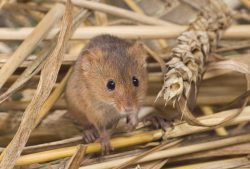
Responding to the research, Andrew Lee, Director of Countryside Policy and Management at the South Downs National Park, said: “We welcome the publication of the report, which reveals just how much nature needs us at this critical time. It’s a watershed moment for wildlife that should make us all take stock and, if we’re to turn a corner as a nation, the decisions made over the next few years are going to be so important.
“There’s bad and good news to take away. The bad news is that our key species are still declining and by an average of 19% since 1970. There are fewer of them and they are found in fewer places. This tells us that nature as a whole is really struggling.
“The good news is that we know what we need to do and how to do it. The report found that nature recovery action makes a difference. We just need to work harder, faster and most importantly, work together. This is why the National Park Authority launched our 10-year ReNature campaign in 2021 with an ambitious target that 33% of the National Park is managed for nature by 2030. The aim is that the other 67% is also good for nature, giving nature every opportunity to thrive and for everyone to be able to have access to it.
“No-one is pretending this is going to be easy – there’s so much work that needs to be done. It’s going to require a huge collective effort, partnership working on a scale we’ve never seen before, and most crucially, the right resourcing in order to get nature back on track.”
The National Park’s ReNature initiative is looking to create 13,000 hectares – an area three times the size of Portsmouth – of new habitat, including new woodlands, wetlands and wildflower meadows.
 Andrew added: “Our nature recovery programme to date has largely been focused on habitats, but by getting the habitats ‘bigger, better, and more joined up’ that will support our species, such as hazel dormouse, otter and water vole. Work is now under way to develop a species component to our programme, focusing on restoring habitat for some of our most important and endangered animals and plants.
Andrew added: “Our nature recovery programme to date has largely been focused on habitats, but by getting the habitats ‘bigger, better, and more joined up’ that will support our species, such as hazel dormouse, otter and water vole. Work is now under way to develop a species component to our programme, focusing on restoring habitat for some of our most important and endangered animals and plants.
“It’s important to say that nature recovery action does not just sit with organisations such as National Parks and Wildlife Trusts. The beauty of it is that we can all make a difference. Whether it’s by planting more wildflowers in your garden, a business pledging to help nature, or volunteering in your local community, every little action could make a big impact in the long-run.”
To find out more about the ReNature campaign visit www.southdowns.gov.uk/renature/
Make a pledge to help nature and climate here: www.southdowns.gov.uk/pledge/
What is the South Downs National Park doing to tackle the biodiversity crisis?
The report identifies some key areas for action and listed below are some examples of proactive work taking place in the South Downs National Park.
- Targeted species recovery action.
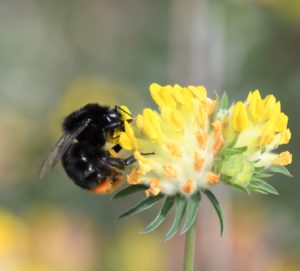 A 13% decline in invertebrates and 54% decline in plants species is particularly worrying because these species are the foundation of the food chain. They are the early warning that nature is in decline and mean that there could be knock on effects higher up the food chain, in birds and mammals. The decline in pollinators’ range of 18% will have a direct impact on our food.
A 13% decline in invertebrates and 54% decline in plants species is particularly worrying because these species are the foundation of the food chain. They are the early warning that nature is in decline and mean that there could be knock on effects higher up the food chain, in birds and mammals. The decline in pollinators’ range of 18% will have a direct impact on our food.
Example of how SDNP is taking on the challenge: More than 66 hectares of wildflower habitat has been created to help pollinators flourish through the Bee Lines campaign.
- Tackling the root cause of species decline – ReNature
The report suggests that species such as water voles, dormice and adders have declined significantly. These species are health indicators for habitats – water voles for rivers and streams, dormice for woodland and hedges and adders for heathland and grassland. Action for species needs to increase the space for species – Renature – and tackle the condition of our existing habitats.
Example of how SDNP is taking on the challenge: We’ve worked with landowners on the River Meon to get the habitat right so water voles could be successfully released.
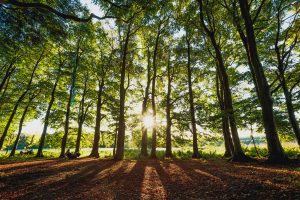 Over 28,000 trees have been planted in the past two years as part of the Trees for the Downs initiative to help create habitat for species such as the hazel dormouse.
Over 28,000 trees have been planted in the past two years as part of the Trees for the Downs initiative to help create habitat for species such as the hazel dormouse.
Our work as a Local Planning Authority prioritises biodiversity through the South Downs Local Plan and there have already been a number of successful schemes supported through the planning function, such as reintroducing the Natterjack toad to Blackmoor. There has been a 36% average Biodiversity Net Gain on the largest scale development sites in 2022/23 as well as gains on smaller sites, through applying Local Plan policies around Ecosystems Services and Biodiversity Net Gain.
- Coordinated action.
The report points out that nature recovery needs to be coordinated and largescale, taking an ecosystem approach. The Authority is developing and supporting a range of projects with diverse partners to deliver for people and nature.
Example of how SDNP is taking on the challenge: Changing Chalk is a multi-partner, multi-project initiative led by the National Trust and aiming to restore lost habitats, including precious chalk grassland across the South Downs.
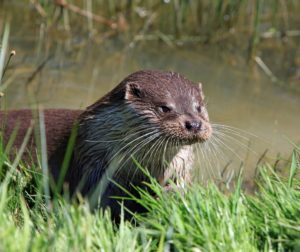 The work of the Meon Valley Partnership in reducing pollution and managing invasive species has seen the return of otters.
The work of the Meon Valley Partnership in reducing pollution and managing invasive species has seen the return of otters.
Our heathlands partnerships have been working for several years to protect lowland heaths that are home to rare birds, reptiles and amphibians. There is early ecological evidence that some of the bird populations are bouncing back.
- Nature-friendly farming
The area of farms in agri-environment schemes has increased in the UK as a whole and pesticide and fertiliser use has decreased, but farmland bird species have declined significantly by 58%. Nature friendly farming needs to be targeted – to get the right action in the right place.
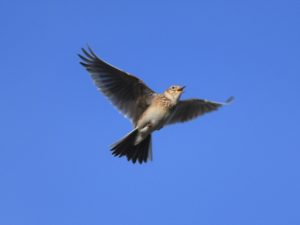 Example of how SDNP is taking on the challenge: South Downs farmers are taking a lead through farming cluster groups that encourage nature-friendly agriculture. As a result, early indications are that populations of farmland birds in the National Park are bucking the trend by holding steady. The Selborne Landscape Partnership of farmers has seen particular success and this year published a study showing that wildlife was holding up well in the Selborne area thanks to nature-friendly farming practices.
Example of how SDNP is taking on the challenge: South Downs farmers are taking a lead through farming cluster groups that encourage nature-friendly agriculture. As a result, early indications are that populations of farmland birds in the National Park are bucking the trend by holding steady. The Selborne Landscape Partnership of farmers has seen particular success and this year published a study showing that wildlife was holding up well in the Selborne area thanks to nature-friendly farming practices.
The Farming in Protected Landscapes scheme (FiPL), administered by the National Park Authority, has supported well over 70 projects to help kickstart nature recovery and take climate action. Highlights include more than 3,600m of new hedgerow being created and management improved at 2,300 hectares of land at Sites of Special Scientific Interest (SSSI).
- The power of volunteers.
The report points out the amazing and important work that volunteers do for nature from recording species to managing land.
Example of how SDNP is taking on the challenge: This statistic is taken from the SDNPA annual report 20-21 and shows just how vital volunteers are to National Parks. The Authority also has a strong emphasis on youth volunteering with several Youth Action events throughout the year.
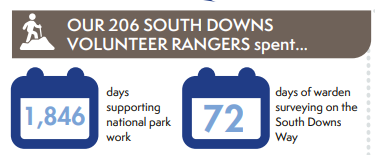
- Unlocking green finance.
The report points out that public sector funding for nature conservation has decreased by 24% over the last five years.
Example of how SDNP is taking on the challenge: South Downs National Park Authority is tackling this in a variety of ways:
- By working with South Downs National Trust, an independent charity fundraising for the Park.
- Developing green finance initiatives such as ReNature Credits. Earlier this year the National Park Authority launched the innovative scheme to restore biodiversity and deliver nature-based climate action. Developers are now able to acquire ReNature Credits through the National Park Authority’s brokerage service for Biodiversity Net Gain. The brokerage service has initially launched with two strategic sites: Iford Estate and Warnford Park Estate. Developers and landowners are invited to get in touch with the Authority to find out more by filling in the form here or alternatively emailing ReNaturecredits@southdowns.gov.uk
- Tackling climate change
The report reiterates impacts of climate change on nature and the need to pursue net zero targets and ensure that nature has the space to adapt. The South Downs National Park Authority sees climate change and nature recovery as interlinked.
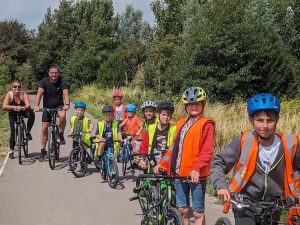 Example of how SDNP is taking on the challenge: Ouse Valley Climate Action is a National Lottery-funded programme bringing the community together to inspire positive action to mitigate the effects of climate change in the lower Ouse Valley and Havens.
Example of how SDNP is taking on the challenge: Ouse Valley Climate Action is a National Lottery-funded programme bringing the community together to inspire positive action to mitigate the effects of climate change in the lower Ouse Valley and Havens.
- Action at Seven Sisters Country Park
The National Park Authority took ownership of Seven Sisters Country Park two years ago and it’s one of only two spots in the 1,627km2 that the Authority actually owns (the other being the South Downs Centre in Midhurst).
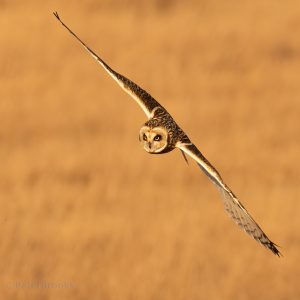 Within two years:
Within two years:
- Two ponds have been restored (one which has been dry for decades) and are now brimming with dragonflies and chasers.
- Chalk grassland condition has greatly improved in several patches – a key indicator being greater numbers of clustered bellflowers.
- Vegetated shingle has been fenced off and is recovering from human disturbance.
- Sensitive grazing of semi-improved grassland is supporting a healthy population of birds of prey, such as the short-eared owl, and large murmurations of starlings.
- Practical work with corporate volunteers has greatly reduced areas of scrub on chalk grassland slopes and improved the floristic diversity of the chalk grassland.
